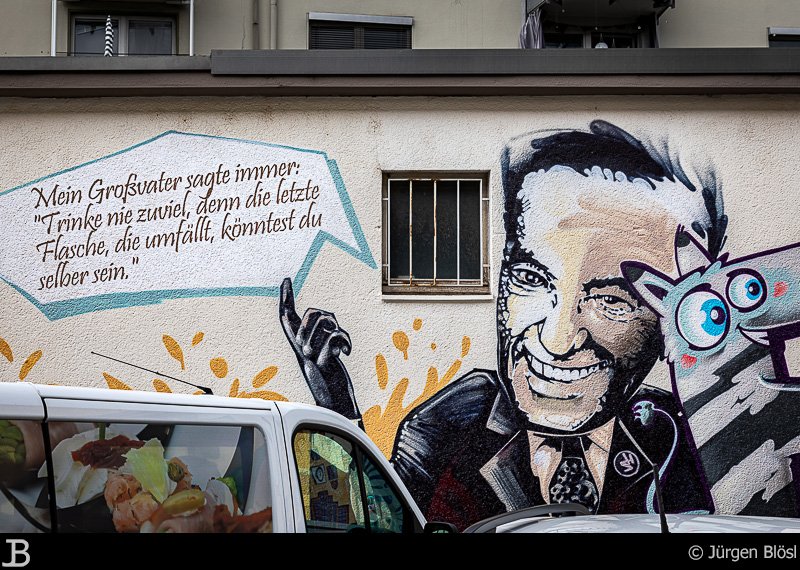Death Valley - Wild Wild West - USA 2022 - 2
24/25.02 - Death Valley
I stop in Stovepipe Wells to buy the annual pass for the National Parks [↗]. It's not clear if it really pays off but already the entrance fees for Death Valley and Saguaro National Park in Tucson together are almost as expensive and if not it's for a good cause.
From here I drive on to Beatty. Beatty is the first town after Death Valley and is already in Nevada. Since the two hotels inside the national park are super expensive for what they offer, Beatty is a good alternative. It's my first extended visit to Death Valley since 2000, and I'll be staying at the same motel as last time, the Exchange Club.
Since it is only afternoon, I change the plan a little. Instead of driving Artist Drive, I want to visit Rhyolite (which is next to Beatty anyway) and then drive up to Bad Water Point.
I was already in Rhyolite on my last trip but only looked at the art exhibits at the beginning. Now I also want to drive to the end to have a look at the old ruins. So after the art exhibition, which I of course visit again, I drive to the Bottle House and then to the old train station. It may not be a complete waste of time and certainly of some historical significance, but for me, the exhibits are much more interesting than the rest.
Now I still want to get to Bad Water Point [↗]. When I enter the destination into my Garmin GPS, I have to realize that I have clearly underestimated the distances here in Death Valley. But ok, so it will be a blue hour shooting instead of a sunset.
I arrive just as the sun has disappeared behind the mountains. I park my car, grab the tripod and join the many people who are now still going down into the salt lake. At first, all you see is white powder, because all the hundreds of people who come here every day don't leave any intact salt structures. I walk for half an hour until there are only a few others with me. Now geometric structures can be seen along the way. Before it gets too dark, I pick one that looks interesting, set up my tripod, and start taking pictures.
Now I "only" have to go back to the car. Even though it's getting dark now, you can't go wrong. My eyes have become sufficiently accustomed to the residual light to recognize the wide path. I do not need the headlamp that I carry with me.
The next morning I leave at 5:30 to take some sunrise photos of the Mesquite Flat Sand Dunes [↗]. On the drive from Beatty to the main road of the National Park, the NV-190, I don't see a single car. I begin to wonder if I would really be alone in the dunes. But no way, at the parking lot are already 8 other cars, and considering how far away some of the people are, they must have started at least 30 minutes earlier. But the dunes are big enough for everyone to find their spot.
Unlike most other people, I turn right. I start taking pictures in the direction of the rising sun until it is high enough to light up the mountains to the west. Now it's getting harder and harder to avoid other people in the picture, but from time to time I intentionally pick one up to emphasize the size of the dunes.
As the sun climbs higher, I return to the car and drive the short distance to Harmony Borax Works. I get there at 7:30 and there is only one other car in the parking lot. The 20-Mule-Team-Wagon used to transport processed borax to Mojave [↗] around 1885 is perfectly situated in the morning light. I also drive through the adjacent Mustard Canyon. You can do that if you're here anyway and have an SUV, but you won't miss much if you skip it.
My original plan for the day was to drive through Titus Canyon, but then I read in the newspaper you get at the National Park the suggestion for a hike: Golden Canyon [↗]. There are several ways to continue, including up to Zabriskie Point. But I want to return to the starting point via Gower Gulch and have included the detour to Red Cathedral.
Hiking in Death Valley is usually difficult because of the high temperatures. So this could be a once-in-a-lifetime opportunity to do so. Who knows if I will return here again in winter. If you are here at another time of year, you might be able to walk the first part of Golden Canyon, at least if you leave very early. Then you can find some shade. Later in the day or further back on the trail, you'll have to walk in the full sun. So know your limits!
The nature here is gorgeous. I follow the main canyon, but can't resist exploring one of the side canyons as well. The path is more or less flat and easy to walk. Then I reach the turnoff to Red Cathedral. Now the trail starts to climb, but that's no problem. Next comes a slot canyon where you have to climb a bit to get ahead, but after this part it gets tricky. The whole trail is sandy and slippery. In the slot canyon, the walls are close enough to lean on, but as the trail gets wider and steeper, I'm afraid to slip. Some people use hiking poles, which is certainly a good idea. So at some point, I decide there's no point in taking the risk and return to the main trail.
This is now also ascending and at the latest here you can no longer find shade. The path is not complicated, but you should be surefooted because it leads over a steep slope. Finally, I reach the highest point of my trail. I could continue to Zabriskie Point, but that would be just for the sake of going up. The light is too harsh to take photos, and I haven't taken out my camera in at least an hour.
The way downwards starts very easily through a wide riverbed, where you can really feel the power of the water if it rains here. Then the riverbed suddenly turns into a slot canyon, and you have to climb down some pretty deep steps. With my long legs, I manage that quite easily, but some older people from a hiking group had to fight a bit and are happy that their guide shows up and supports them. There is one more tricky passage where you have to be sure-footed again, and then it's just down the valley back to the parking lot.
The whole area is very well signposted by the way and there were only 2 places where I had to think about how to continue.
After that, I drive back to Beatty to get something for lunch. Based on yesterday's experience, I know that I have to be at Artist Drive at least an hour before sunset to have the rocks in nice light. Later, the sun will be behind the mountains.
But before I go there, I make a side trip to the Keane Wonder Mine[↗]. On the road I take from Beatty towards Furnace Creek, there is a sign I have passed 3 times. Now I want to know what is there. A small gravel road leads up toward the mountains and at the end is a small parking lot for, let’s say, 5 or 6 cars. This is an old mining area and you are asked not to leave the trail. There are some remains of the old mine, partially stabilized by steel and concrete. Nothing overwhelming but more of a ghost town feeling than Rhyolite.
Now, finally, Artist Drive. This is a nine-mile (14.5 km) paved one-way road that winds through the mountainside. The mountains are illuminated by the setting sun and the various colors of the minerals begin to glow. There are two designated parking areas from which one can walk a few yards to viewpoints.
Again it is dark when I return to the hotel. Tomorrow I will leave Death Valley and head for Las Vegas.








































